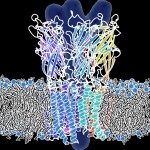Lien vers Pubmed [PMID] – 20308576
Lien vers HAL – Cliquez ici
Lien DOI – 10.1073/pnas.1001832107
Proc. Natl. Acad. Sci. U.S.A. 2010 Apr;107(14):6275-80
Recently discovered bacterial homologues of eukaryotic pentameric ligand-gated ion channels, such as the Gloeobacter violaceus receptor (GLIC), are increasingly used as structural and functional models of signal transduction in the nervous system. Here we present a one-microsecond-long molecular dynamics simulation of the GLIC channel pH stimulated gating mechanism. The crystal structure of GLIC obtained at acidic pH in an open-channel form is equilibrated in a membrane environment and then instantly set to neutral pH. The simulation shows a channel closure that rapidly takes place at the level of the hydrophobic furrow and a progressively increasing quaternary twist. Two major events are captured during the simulation. They are initiated by local but large fluctuations in the pore, taking place at the top of the M2 helix, followed by a global tertiary relaxation. The two-step transition of the first subunit starts within the first 50 ns of the simulation and is followed at 450 ns by its immediate neighbor in the pentamer, which proceeds with a similar scenario. This observation suggests a possible two-step domino-like tertiary mechanism that takes place between adjacent subunits. In addition, the dynamical properties of GLIC described here offer an interpretation of the paradoxical properties of a permeable A13’F mutant whose crystal structure determined at 3.15 A shows a pore too narrow to conduct ions.




